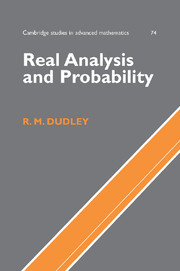Book contents
- Frontmatter
- Contents
- Preface to the Cambridge Edition
- 1 Foundations; Set Theory
- 2 General Topology
- 3 Measures
- 4 Integration
- 5 Lp Spaces; Introduction to Functional Analysis
- 6 Convex Sets and Duality of Normed Spaces
- 7 Measure, Topology, and Differentiation
- 8 Introduction to Probability Theory
- 9 Convergence of Laws and Central Limit Theorems
- 10 Conditional Expectations and Martingales
- 11 Convergence of Laws on Separable Metric Spaces
- 12 Stochastic Processes
- 13 Measurability: Borel Isomorphism and Analytic Sets
- Appendix A Axiomatic Set Theory
- Appendix B Complex Numbers, Vector Spaces, and Taylor's Theorem with Remainder
- Appendix C The Problem of Measure
- Appendix D Rearranging Sums of Nonnegative Terms
- Appendix E Pathologies of Compact Nonmetric Spaces
- Author Index
- Subject Index
- Notation Index
- References
3 - Measures
Published online by Cambridge University Press: 06 July 2010
- Frontmatter
- Contents
- Preface to the Cambridge Edition
- 1 Foundations; Set Theory
- 2 General Topology
- 3 Measures
- 4 Integration
- 5 Lp Spaces; Introduction to Functional Analysis
- 6 Convex Sets and Duality of Normed Spaces
- 7 Measure, Topology, and Differentiation
- 8 Introduction to Probability Theory
- 9 Convergence of Laws and Central Limit Theorems
- 10 Conditional Expectations and Martingales
- 11 Convergence of Laws on Separable Metric Spaces
- 12 Stochastic Processes
- 13 Measurability: Borel Isomorphism and Analytic Sets
- Appendix A Axiomatic Set Theory
- Appendix B Complex Numbers, Vector Spaces, and Taylor's Theorem with Remainder
- Appendix C The Problem of Measure
- Appendix D Rearranging Sums of Nonnegative Terms
- Appendix E Pathologies of Compact Nonmetric Spaces
- Author Index
- Subject Index
- Notation Index
- References
Summary
Introduction to Measures
A classical example of measure is the length of intervals. In the modern theory of measure, developed by Émile Borel and Henri Lebesgue around 1900, the first task is to extend the notion of “length” to very general subsets of the real line. In representing intervals as finite, disjoint unions of other intervals, it is convenient to use left open, right closed intervals. The length is denoted by λ((a, b]) ≔ b – a for a ≤ b. Now, in the extended real number system [−∞, ∞] ≔ {−∞} ∪ ℝ ∪ {+∞}, −∞ and +∞ are two objects that are not real numbers. Often +∞ is written simply as ∞. The linear ordering of real numbers is extended by setting −∞ < x < ∞ for any real number x. Convergence to ±∞ will be for the interval topology, as defined in §2.2; for example, xn → +∞ iff for any K < ∞ there is an m with xn > K for all n < m. If a sequence or series of real numbers is called convergent, however, and the limit is not specified, then the limit is supposed to be in ℝ, not ±∞. For any real x, x + (–∞) ≔, −∞ and x + ∞ ≔, +∞, while ∞ – ∞, or ∞ + (−∞), is undefined, although of course it may happen that an → + ∞ and bn → −∞ while an + bn approaches a finite limit.
- Type
- Chapter
- Information
- Real Analysis and Probability , pp. 85 - 113Publisher: Cambridge University PressPrint publication year: 2002
References
- 1
- Cited by



